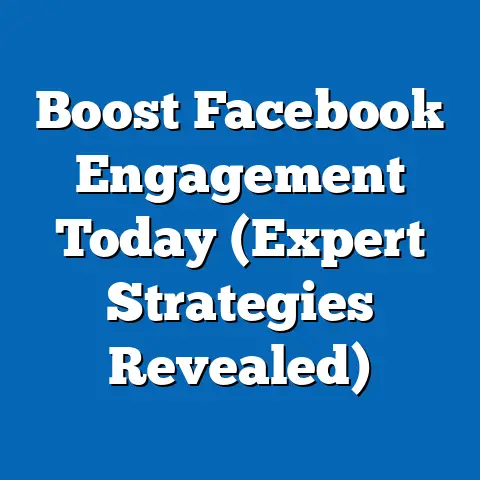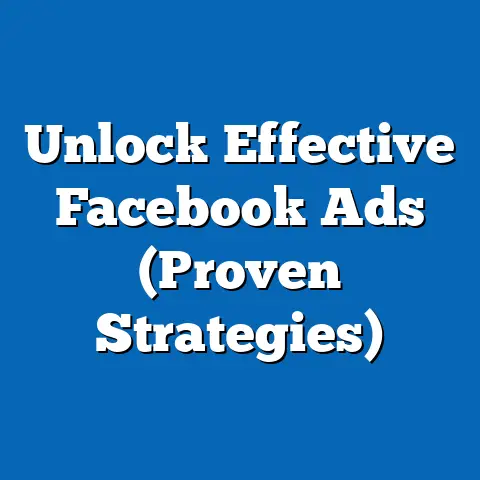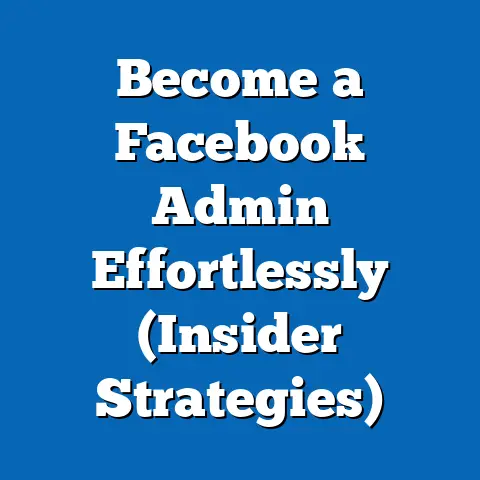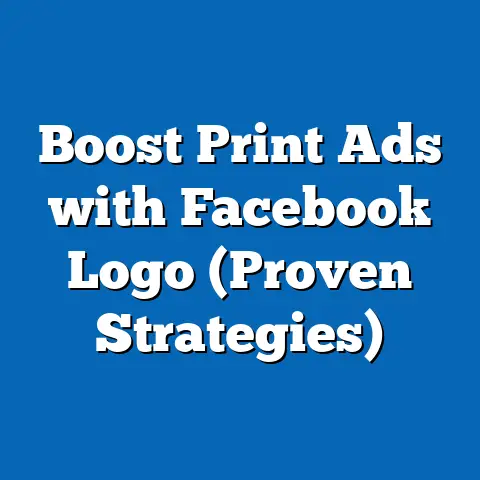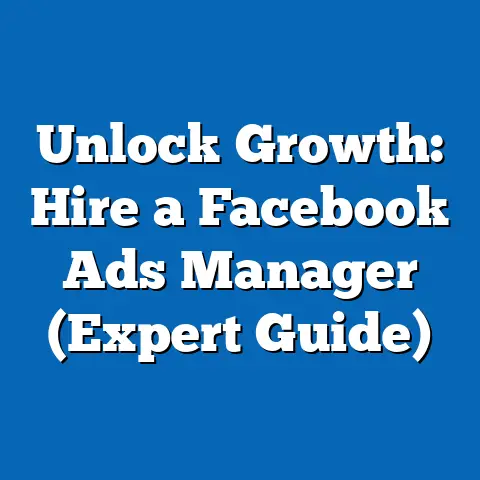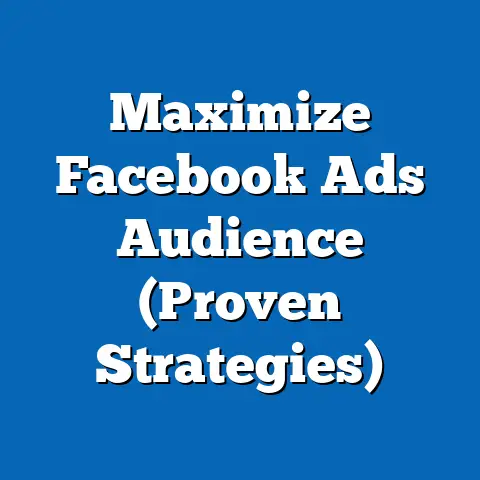Unlock Top Ad Formats for Facebook (Proven Strategies)
It’s funny, I remember when my niece, Lily, was just a toddler. My sister, obsessed with finding the perfect organic toys, would spend hours scrolling through Facebook groups, looking for recommendations. That’s when it hit me: Facebook isn’t just a social platform; it’s a marketplace for parents searching for the best for their kids. In today’s digital age, engaging with parents and guardians effectively on Facebook is crucial, especially when it comes to advertising children’s products and services. Choosing the right ad format is like picking the right tool for the job – it can make all the difference in capturing their attention and, ultimately, driving sales. The landscape is shifting, with digital marketing becoming increasingly focused on connecting with families online. Facebook, with its massive user base and sophisticated targeting options, sits right at the heart of this trend.
Understanding Your Audience: The Parent Persona
When I started working with a local children’s bookstore, I realized how diverse the “parent” demographic truly is. You have the eco-conscious moms, the tech-savvy dads, the grandparents who want to spoil their grandkids – each with unique interests and needs. Understanding these nuances is critical for crafting effective Facebook ads.
Demographically, parents on Facebook span a wide age range, typically from 25 to 55, with varying levels of education and income. Their interests are equally diverse, ranging from parenting tips and educational resources to family travel and healthy recipes. Behaviors such as engaging with parenting groups, liking pages related to children’s products, and sharing articles about child development offer valuable insights. Purchasing patterns often revolve around convenience, quality, and value for money.
But beyond the demographics, it’s the emotional triggers that truly resonate with parents. Safety is paramount; they want to ensure any product they buy for their child is safe and non-toxic. Education is another key driver; parents are always looking for ways to enrich their children’s learning experiences. And, of course, fun! They want products that will bring joy and laughter to their kids’ lives.
Creating detailed customer personas is essential. A persona should include:
- Demographics: Age, location, income, education
- Interests: Hobbies, favorite brands, online communities
- Pain Points: Challenges they face as parents
- Motivations: What drives their purchasing decisions
- Preferred Ad Format: e.g., Video ad showing a product solving a common problem
Takeaway: Before launching any Facebook ad campaign, take the time to research and understand your target audience. Create detailed parent personas that capture their demographics, interests, pain points, and motivations. This will inform your ad format choices and messaging.
Overview of Facebook Ad Formats: A Playground of Possibilities
Facebook offers a diverse range of ad formats, each with its own strengths and weaknesses. When promoting children’s products or services, it’s crucial to choose formats that are visually appealing, engaging, and convey your message effectively. Here’s a quick rundown:
- Image Ads: Simple, yet powerful, image ads are ideal for showcasing a single product or highlighting a key benefit.
- Video Ads: Video ads are incredibly effective for storytelling and demonstrating how your product works.
- Carousel Ads: Carousel ads allow you to showcase multiple products or features in a single ad, creating a more interactive experience.
- Slideshow Ads: Slideshow ads are a budget-friendly option for creating engaging visual content using a series of images or videos.
- Collection Ads: Collection ads are designed for e-commerce businesses, allowing users to browse and purchase products directly from the ad.
Visual appeal and storytelling are paramount when targeting parents. Ads should feature vibrant colors, relatable imagery, and positive messages that resonate with their values. Think happy children, loving families, and products that make life easier.
Takeaway: Facebook offers a variety of ad formats, each suited for different purposes. Choose formats that are visually appealing, engaging, and align with your marketing goals.
Proven Strategies for Each Ad Format: Cracking the Code
This is where the rubber meets the road. Let’s dive into specific strategies for maximizing the effectiveness of each ad format when targeting parents on Facebook.
Image Ads: Simplicity and Impact
I’ve seen image ads work wonders for children’s products, especially when they focus on a single, compelling benefit. The key is to choose images that are high-quality, visually appealing, and emotionally resonant.
Takeaway: Image ads can be highly effective if you focus on high-quality visuals, clear messaging, and a strong call-to-action.
Video Ads: Storytelling at its Finest
Video ads are my personal favorite. They allow you to connect with parents on an emotional level, tell a compelling story, and demonstrate the benefits of your product in a visually engaging way.
- Strategy: Create engaging video content that highlights the benefits of your product for children.
- Example: A video ad for an educational toy showing children interacting with the toy and learning new skills.
- Key Elements:
- Engaging storyline: A narrative that captures attention and resonates with parents.
- Visual appeal: High-quality video production with vibrant colors and clear visuals.
- Demonstration: Show how the product works and its benefits for children.
- Testimonials: Include testimonials from satisfied parents.
- Clear call-to-action: “Shop Now” or “Learn More.”
- Engaging storyline: A narrative that captures attention and resonates with parents.
- Visual appeal: High-quality video production with vibrant colors and clear visuals.
- Demonstration: Show how the product works and its benefits for children.
- Testimonials: Include testimonials from satisfied parents.
- Clear call-to-action: “Shop Now” or “Learn More.”
I once helped a children’s clothing brand create a video ad that showcased their new line of organic cotton clothing. The video featured kids playing in the clothes, highlighting their comfort, durability, and eco-friendliness. The campaign resulted in a 50% increase in online sales.
Takeaway: Video ads are a powerful tool for storytelling and demonstrating the benefits of your product. Focus on creating engaging content that resonates with parents on an emotional level.
Carousel Ads: Showcase Multiple Products
Carousel ads are perfect for showcasing multiple products or features in a single ad. They allow you to create a more interactive experience and guide viewers through a narrative.
- Strategy: Create a narrative that guides viewers through the carousel, highlighting the key benefits of each product.
- Example: A carousel ad for a children’s subscription box, with each card showcasing a different item from the box.
- Key Elements:
- Compelling visuals: High-quality images or videos for each card.
- Clear headlines: Concise headlines that highlight the key benefit of each product.
- Engaging descriptions: Short descriptions that provide more detail about each product.
- Strong call-to-action: “Shop Now” or “Learn More” for each card.
- Compelling visuals: High-quality images or videos for each card.
- Clear headlines: Concise headlines that highlight the key benefit of each product.
- Engaging descriptions: Short descriptions that provide more detail about each product.
- Strong call-to-action: “Shop Now” or “Learn More” for each card.
I worked with a children’s bookstore that used carousel ads to showcase their top-selling books. Each card featured a different book, with a brief synopsis and a link to purchase. The campaign resulted in a 40% increase in online book sales.
Takeaway: Carousel ads are a great way to showcase multiple products or features in a single ad. Focus on creating a narrative that guides viewers through the carousel and highlights the key benefits of each product.
Slideshow Ads: Budget-Friendly Storytelling
Slideshow ads are a budget-friendly option for creating engaging visual content. They allow you to tell a story using a series of images or videos, making them ideal for brands with limited video production resources.
- Strategy: Craft engaging slideshows that tell a story and highlight the benefits of your product.
- Example: A slideshow ad for a children’s summer camp, with each slide showcasing a different activity.
- Key Elements:
- High-quality images: Choose visually appealing images that capture attention.
- Clear messaging: Use concise text overlays to highlight key benefits.
- Engaging transitions: Use smooth transitions between slides to create a seamless experience.
- Background music: Add background music to enhance the emotional impact.
- Strong call-to-action: “Register Now” or “Learn More.”
- High-quality images: Choose visually appealing images that capture attention.
- Clear messaging: Use concise text overlays to highlight key benefits.
- Engaging transitions: Use smooth transitions between slides to create a seamless experience.
- Background music: Add background music to enhance the emotional impact.
- Strong call-to-action: “Register Now” or “Learn More.”
I helped a local daycare center create a slideshow ad that showcased their facilities, staff, and activities. The ad featured happy children engaged in various learning and play activities. The campaign resulted in a significant increase in enrollment inquiries.
Takeaway: Slideshow ads are a budget-friendly way to create engaging visual content. Focus on choosing high-quality images, using clear messaging, and creating a seamless experience.
Collection Ads: Seamless Shopping Experience
Collection ads are designed for e-commerce businesses, allowing users to browse and purchase products directly from the ad. They’re particularly effective for showcasing a curated selection of children’s products.
- Strategy: Create a seamless shopping experience for parents looking for children’s products.
- Example: A collection ad for a children’s clothing store, with a curated selection of outfits for different occasions.
- Key Elements:
- Visually appealing catalog: Showcase your products in a visually appealing and organized manner.
- High-quality images: Use high-quality images that showcase the products in detail.
- Clear pricing: Display the price of each product clearly.
- Easy navigation: Make it easy for users to browse and purchase products.
- Mobile-optimized: Ensure the ad is optimized for mobile devices.
- Visually appealing catalog: Showcase your products in a visually appealing and organized manner.
- High-quality images: Use high-quality images that showcase the products in detail.
- Clear pricing: Display the price of each product clearly.
- Easy navigation: Make it easy for users to browse and purchase products.
- Mobile-optimized: Ensure the ad is optimized for mobile devices.
I worked with an online children’s toy store that implemented collection ads. They saw a 60% increase in mobile sales after optimizing their product catalog and creating visually appealing collection ads.
Takeaway: Collection ads are a powerful tool for driving e-commerce sales. Focus on creating a seamless shopping experience for parents and optimizing your product catalog for visual appeal and easy navigation.
Creative Elements and Best Practices: The Secret Sauce
Beyond the ad format, the creative elements you use can make or break your campaign. Here are some best practices to keep in mind:
- Playful Language: Use playful language that resonates with parents and children.
- Relatable Scenarios: Create ads that depict relatable scenarios that parents can connect with.
- Positive Imagery: Use positive imagery that evokes feelings of joy, happiness, and security.
- A/B Testing: Continuously test different ad formats, creative elements, and targeting options to optimize your campaigns.
- Clear Calls-to-Action: Use clear and concise calls-to-action that tell parents exactly what you want them to do.
- Tailored Landing Pages: Direct users to landing pages that are specifically tailored to their needs and interests.
Takeaway: Creativity is key to capturing the attention of parents on Facebook. Use playful language, relatable scenarios, and positive imagery. Continuously test different elements to optimize your campaigns.
Measuring Success and Optimization: Data-Driven Decisions
It’s not enough to just launch your ads and hope for the best. You need to track your results, analyze your data, and continuously optimize your campaigns. Here are some key metrics to monitor:
- Engagement Rate: Measures how engaging your ads are to parents.
- Click-Through Rate (CTR): Measures the percentage of people who click on your ads.
- Conversion Rate: Measures the percentage of people who take a desired action, such as making a purchase.
- Cost Per Acquisition (CPA): Measures the cost of acquiring a new customer.
- Return on Ad Spend (ROAS): Measures the return on investment for your ad campaigns.
Takeaway: Track your results, analyze your data, and continuously optimize your campaigns based on performance data.
Conclusion: The Path to Facebook Ad Success
Choosing the right Facebook ad format is crucial for capturing the attention of parents and driving sales for children’s products and services. By understanding your audience, selecting the right formats, and implementing proven strategies, you can create effective campaigns that resonate with parents and achieve your marketing goals. Don’t be afraid to experiment, test, and optimize. The world of Facebook advertising is constantly evolving, so stay curious, stay informed, and stay creative. I encourage you to dive in, try different approaches, and see what works best for your business. The potential for increased engagement and sales is immense!

